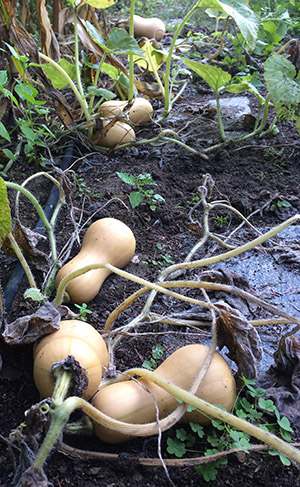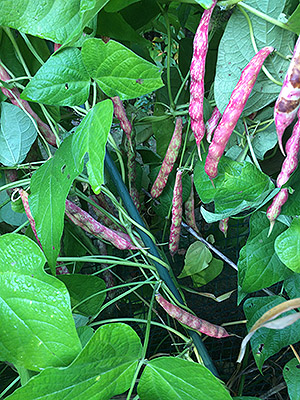
For a “survival garden,” it’s hard to beat the Three Sisters — corn, beans, and squash. Their produce stores well and provide balanced nutrition. This year’s experiment with the Sisters turned out rather well. Each sister her own “room” instead of interplanting. They seemed happier.
This year’s harvest was encouraging for a survival-type garden. This was the best corn yield yet for my garden. Someone from Iowa would not be impressed, but I was. The last of the beans are shelled and drying. They’re looking to be a best-yield too. The squash did okay: not a record, but pretty good.
The Official Three-Sisters Method
The native method is to plant the corn and beans in the same mound of soil so that the beans can climb on the corn stalks. The nitrogen-fixing roots of the beans provide nutrients for the nutrient-hungry corn roots. Symbiotic. Squash seeds are planted between the mounds so that their broad leaves shade out weeds. Companion-planting harmony.
The official method may work well elsewhere but it hasn’t worked too well in my garden. Not being the best spot for corn, their stalks don’t tend to grow particularly big and strong. Pole beans seem happy enough in my garden. Their vigor has usually been too much for my meager cornstalks to bear. The many bean leaves also tended to get in the way of pollen falling from the tassels to the silk. Those two sisters did not get along too well.
Semi-private Rooms

This year’s variation was to try separating the sisters a bit: give them their own rooms, so to speak. Instead of planting the corn in mounds, I planted them evenly spaced, staggered, in three rows. They need proximity to each other for pollination. I planted the beans in a row right behind the corn: close enough that their roots could still intermingle. The beans got their own separate poles to climb instead of the stalks. The squashes

The corn sister was happy with her own room. The stalks grew taller. A few even tried to put out a second ear. (Those second ears didn’t usually amount to much, but were a sign of sister happiness.) The primary ears were longer and more fully developed for kernels than they had been in previous years. My theory is that the bean leaves may have been masking the silk, preventing pollen from getting through, resulting in snaggle-toothed ears.

The bean sister was super-happy with her own room. Oof-dah, (as the old Norwegians say in Minnesota) this year’s beans grew like kudzu. The weight of the plants pulled over the line of poles and even broke a few of them. I resorted to some props behind the row to keep it all from collapsing. The plants had lots and lots of bean pods.
The squash sister was not as impressed with her freedom but did okay. There were more squash “fruits” than usual but they were smaller than before. That may actually be okay if it means there’s a better ‘meat’ to ‘seed’ ratio.
Sisters In Storage: Survival Value

One of the reasons the Native-Americans relied upon the Three Sisters is that their produce stored well for winter consumption. Unlike many garden foods with very short shelf lives (tomatoes, zucchini, lettuce, etc.) the sisters are good for the long term. This makes them valuable for the prepper-survivalist.
Once dried, corn kernels keep for years. When needed, they can be soaked in wood-ash water (usually overnight) to soften the tough outer shell, then rinsed (thoroughly). The kernels are boiled to become hominy. Via a chemical reaction with the wood ash, the corn’s B-vitamins become available for human digestion. (not the case with simply-ground corn). The hominy can also be mashed into a dough called masa which can be dry-fried into corn tortillas. Hominy itself can be dried too for longterm storage and grinding into a fine flour (Masa

Dried beans keep for years too. Beans must be soaked overnight and rinsed before boiling. but other than that, they’re easy to cook. Combined, hominy and beans make a rather complete food source — carbs, nutrients,
Winter squash, unlike summer squash varieties like zucchini, keep well during the cold and dry months of winter. When desired, they can be cut up and boiled to add more vitamins to the corn and beans meals.
Learning What Makes Sisters Happy
It’s pretty common for prepper-survivalists to include planting a garden as part of their long-term plans. Even a year’s worth of stored food runs out after a year. Then what? A serious prepper almost has to plan on gardening. The sustainable solution is growing new food. The thing to realize is: getting a garden to produce enough to actually sustain you (not just a few fresh tomatoes to top your salad) takes practice. It’s not
A prepper’s survival garden needs to plan ahead for the lean winter months when nothing is growing outside. When the frost comes, kale, broccoli, and tomatoes will abandon you. The three sisters arrive late (being a fall harvest) but they will stay with you all winter.
That is why I keep experimenting. If push comes to shove and I need to rely upon my garden, I want to already know what works in my location, what doesn’t, and how best to have happy sisters.
That is what I’d like to encourage you to do too. Plant a garden next spring. Try it out. What grows well in your garden? Not everything will. After a few seasons, you’ll know what grows like gangbusters and what is a waste of your effort. If push comes to shove, you want to know what will work for you and what not to waste your time on. (For me, it’s broccoli. All I ever get is a lovely bunch of leaves — maybe a flower head the size of a silver dollar. Lots of space, time, and effort for too little reward.)
Gardening isn’t “
Think about the sisters. They might just save you.

Mic I am impressed with your idea about modifying the 3 sisters system.
I too did not have much success with my attempts the last two years. I was using dent corn, French horticultural beans (very tasty fresh AND dry and fruitful) and Butternut squash.
The beans did OK but they did need extra supports, the squash decently and the corn was a disappointment. Just a few decent ears, not even one per plant. I think the beans almost killed the corn.
Could you please let us know what corn, bean and squash seeds you used?
Also do you have a recommendation as to seed supplier?
What is your Anti-Deer system please? Also voles are quite an annoyance. I may yet get a rat terrier for both gardening issues.
Hi Michael,
Glad to hear I’m not the only one trying to make the Three Sisters work. It sounds like your beans did to your corn what mine did last year. For seeds, I started out with “Roy Calias Flint Corn” from High Mowing Seeds, but have been seed-saving off of that for years. I’ve liked High Mowing for seeds. Organic and heritage breeds — like the Flint Corn.
I’ve been doing the French Horticultural Beans too. Same seed-saving. I’ve tried variants like rattlesnake beans and vermont cranberry. They do okay, but French do best for my garden. We also do the butternut squash, though buttercup squash is favored by the wife. Sugar pumpkin has worked too. (and they make great pie!)
As for predators, we don’t have much trouble with deer up around the gardens. They’re too close to the house and not near handy cover. I’ve seen tracks down around the fruit trees, though. (closer to good cover). Yes, voles can be a problem. They ravaged our beets a couple years ago. I’ve been trapping those with conventional mousetraps, since they’ll come above ground (unlike moles). Gray squirrels are my primary nemesis. That, and chipmunks. I use traps for them or apply lead-fencing whenever possible.
Hope this helps, and hope the sisters do better for you next season.
— Mic